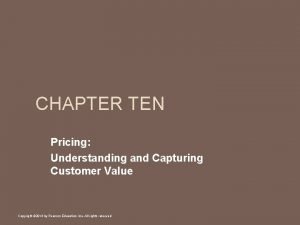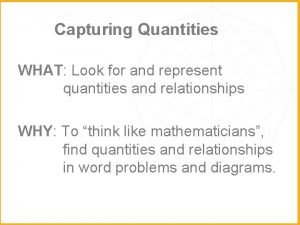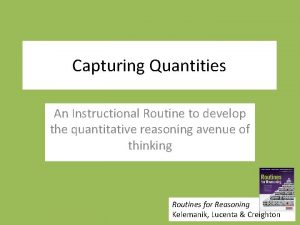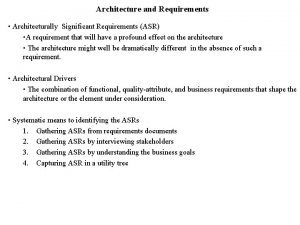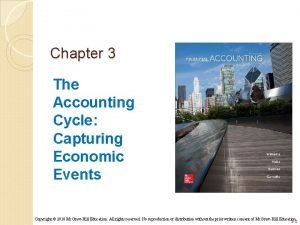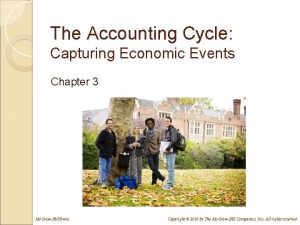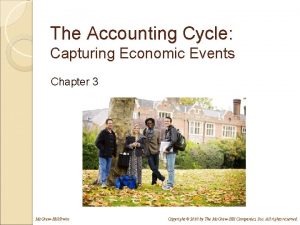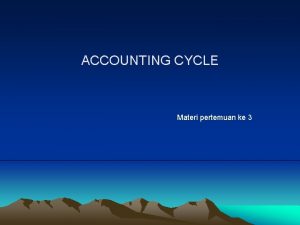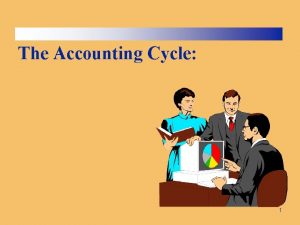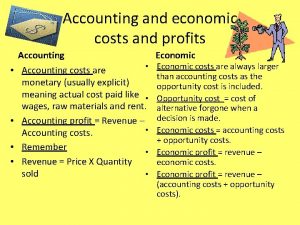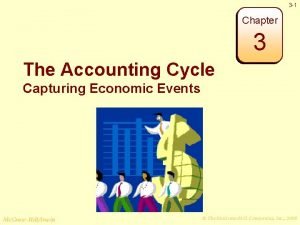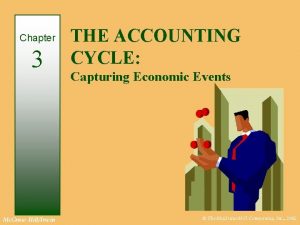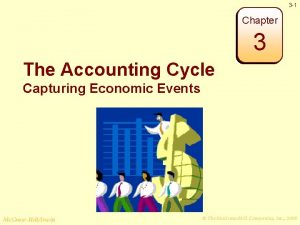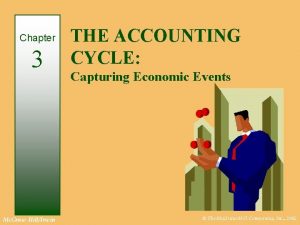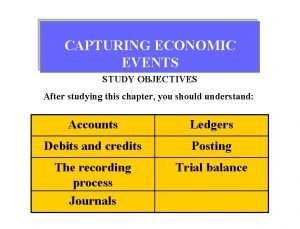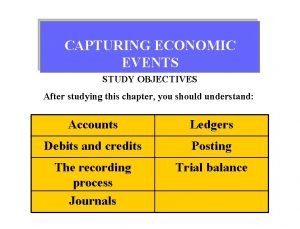The Accounting Cycle Capturing Economic Events Lecture 2

























- Slides: 25

The Accounting Cycle: Capturing Economic Events Lecture 2

The Concept of Business Entity � Entity Principle �A business entity is an economic unit that engages in identifiable business activities � Separate owner from the personal affairs of its

Assets � Current ◦ ◦ ◦ Assets Cash and cash equivalents Accounts receivables, trade receivables Prepaids and advances Inventory Financial assets such as trading securities, investment securities � Non-Current/Fixed Assets ◦ Property, Plant and Equipment ◦ Investment property ◦ Intangible assets (patents, trademarks, licenses, copyright, goodwill) ◦ Loans receivables

Asset Valuation � The Cost Principle ◦ The Going Concern Assumption ◦ The Objectivity Principle ◦ The Stable-Dollar Assumption

Liabilities � Short Term/Current Liabilities � Long Term/Non-Current Liabilities ◦ Accounts payable – Generally payable to suppliers/vendors ◦ Notes Payable – Interest bearing loan, less than a year maturity ◦ Provisions or accrued liabilities ◦ Unearned revenue ◦ Interest payable ◦ Notes Payable – Short term, interest bearing loan ◦ Debt payable/Long term loan ◦ Bonds/Debentures ◦ Notes Payable – Interest bearing loan, more than a year maturity

Owner’s Equity � Increases through ◦ Investments of cash or other assets by the owner ◦ Earnings from profitable operation of the business � Decreases through ◦ Withdrawals of cash or other assets by the owner ◦ Losses from unprofitable operation of the business

Owner’s Equity � Sole Proprietorship � Partnership � Corporation

Statement of Financial Position – Balance Sheet

Practice Questions � Exercise 2. 3 � Exercise 2. 8

The Accounting Equation � Assets � The = Liabilities + Owner’s Equity effects of Business Transactions ◦ Exercise 2. 6

Net Income � Revenues ◦ Revenue, sales ◦ Gains ◦ Investment income (e. g. , interest and dividends) � Expenses ◦ ◦ ◦ ◦ Cost of Goods Sold Selling, general, and administrative expenses (‘SG&A’) Rent, utilities, salaries and advertising expenses Depreciation and amortization Interest expense Tax expense Losses

Net Income � Net income is an increase in owners’ equity resulting from the profitable operation of the business � Net Income always results in the increase of Owner’s Equity

Income Statement

How is Income Statement related to Balance Sheet � Net Income is reported to the Owner’s Equity Section of the Balance Sheet

The Accounting Cycle � The sequence of accounting procedures used to record, classify, and summarize accounting information in financial reports at regular intervals is often termed the accounting cycle

The Accounting Cycle � Analyzing and recording transactions via journal entries � Posting journal entries to ledger accounts � Preparing unadjusted trial balance � Preparing adjusting entries at the end of the period � Preparing adjusted trial balance � Preparing financial statements � Closing temporary accounts via closing entries � Preparing post-closing trial balance

The Use of Accounts � An account is a means of accumulating in one place all the information about changes in specific financial statement items, such as a particular asset or liability e. g. Cash, Notes Payable

Debit and Credit Entries � Debits refer to the left side of an account, and credits refer to the right side of an account

Debit/Credit Relationships Account Debit (Dr. ) Increase Credit (Cr. ) Decrease Contra Assets Decrease Increase Liabilities Decrease Increase Equity Decrease Increase Revenue Decrease Increase Expenses Increase Decrease Distributions Increase Decrease Assets

The Journal � The information about each business transaction is initially recorded in an accounting record called the journal information is later transferred to the appropriate accounts in the general ledger � This � The journal is a chronological (day-by-day) record of business transactions � Example

General Journal Basic characteristics of the general journal entry: 1. The name of the account debited is written first, and the dollar amount to be debited appears in the left-hand money column. 2. The name of the account credited appears below the account debited and is indented to the right. The dollar amount appears in the right-hand money column. 3. A brief description of the transaction appears immediately below the journal entry.


The Ledger � The entire group of accounts is kept together in an accounting record called a ledger � The transactions from the journal are posted in separate accounts and are accumulated to form a ledger � Example

Determining the Balance of a TAccount � If the debit total exceeds the credit total, the account has a debit balance; if the credit total exceeds the debit total, the account has a credit balance � Debit Balances in Asset Accounts � Credit Balances in Liability and Owners’ Equity Accounts

DOUBLE-ENTRY ACCOUNTING—THE EQUALITY OF DEBITS AND CREDITS � Every transaction is recorded by equal dollar amounts of debits and credits
 01:640:244 lecture notes - lecture 15: plat, idah, farad
01:640:244 lecture notes - lecture 15: plat, idah, farad Mutually exclusive vs non mutually exclusive
Mutually exclusive vs non mutually exclusive Definition of public sector accounting
Definition of public sector accounting Economic growth vs economic development
Economic growth vs economic development Prof. meier and baldwin
Prof. meier and baldwin Chapter 1 lesson 2 our economic choices worksheet answers
Chapter 1 lesson 2 our economic choices worksheet answers Capturing kids hearts four questions
Capturing kids hearts four questions Capturing marketing insights examples
Capturing marketing insights examples Capuring
Capuring Capturing value from customers
Capturing value from customers The four questions capturing kids' hearts
The four questions capturing kids' hearts Input devices for capturing images
Input devices for capturing images Capturing reality documentary
Capturing reality documentary Pricing: understanding and capturing customer value
Pricing: understanding and capturing customer value Measuring sources of brand equity
Measuring sources of brand equity Capturing quantities
Capturing quantities Capturing quantities
Capturing quantities What is data capturing with example
What is data capturing with example Asr architecture
Asr architecture Capturing quantities
Capturing quantities Local exhaust ventilation hood
Local exhaust ventilation hood The process of capturing moving images on film
The process of capturing moving images on film Data capturing workshop
Data capturing workshop Marketing concept
Marketing concept Core customer and marketplace concepts
Core customer and marketplace concepts Capturing marketing insights
Capturing marketing insights













